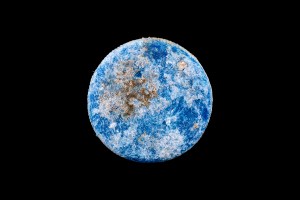New exhibit at Houghton Library features decorated papers
In the 1930s when Boston bookbinder and society matron Rosamond B. Loring (1889–1950) was unable to find ornamental papers she considered good enough to serve as end leaves for her books, she took matters into her own hands, teaching herself to make what are known in bookbinding as “decorated papers.” Her initiative, especially with paste papers, led to a revival in the craft and to an extensive personal collection comprising some 10,000 pieces, examples of which are on display at Houghton Library as part of a new exhibition.
If you’ve ever opened a book to find an ornamental end leaf, you’ve seen decorated paper. “Often in older books you find colored or patterned papers on the end leaves inside the front and back covers, the most common pattern being marbled paper,” says Hope Mayo, Philip Hofer Curator of Printing and Graphic Arts at Houghton Library and organizer of the exhibition.
These decorated papers are, by turns, monochromatic or multicolored, simple or intricate, gilded or not. Although associated with older volumes, publishers still use them today. “Publishers still print special end leaves for particular editions,” says Mayo. “Fine press books, artist’s books, limited editions — these are sometimes still bound in marbled papers or paste papers made for that purpose.”
Loring’s large collection, a gift to Houghton in 1950 upon her death, combines historical examples that date back to the 17th century with papers made by her contemporaries. It also features Loring’s own work and that of her pupil Veronica Ruzicka. “It’s a very important collection, particularly in the categories of paste, marbled, Dutch gilt, and printed papers,” says Mayo.
Each of these four categories is well represented with designs and concepts varying greatly according to a paper’s creator and the technique used. Paste papers, for instance, were Loring’s specialty. “A paste paper is made very simply,” explains Mayo. “You take white paste of a thin consistency and add whatever color you like, usually with watercolors or tempera paints, and you use a paintbrush to spread it out very thinly on the surface of the paper. You can then make patterns in it with your fingers, with rubber stamps, or with anything you want to use.”
The historical Dutch gilt papers in the collection, made primarily in Germany in the 18th century, also used a paste background but were then stamped with a pattern in bronze dust to imitate gold. Historically, they were often used on children’s books.
Also on display are marbled papers — made by creating a colored design with pigments floated on water or a glutinous liquid and then laying a piece of paper on top to pick up the colors — and printed papers, which are indeed printed, the early ones made with wood blocks. “You could have a pattern in a single color, or you could have as many different woodblocks as you wanted different colors in your pattern and you would then print the colors one by one,” notes Mayo.
The Loring collection contains original whole sheets of her work that measure as much as 25 1/2 by 40 inches. Creating a consistent pattern on such large sheets took a steady hand and a good eye, and although she created most of her paper for small print runs, at least once she made enough of one design to cover 4,500 books. “She had to make many sheets of the same thing that looked enough alike that on a single volume they were not discordant,” says Mayo.
In 1942 Loring published her own book, “Decorated Book Papers,” which was written on the basis of her collection and included actual samples of decorated papers. Reprinted twice, once in 1952 and again in 1973, it is due out in a new edition this fall and will include color photographs of the original edition’s samples and an essay by Mayo on Loring’s career. A second publication related to the exhibition will be “Marbled and Paste Papers: Rosamond Loring’s Recipe Book,” which will include a facsimile of her notebook of recipes and an essay on her materials and techniques by Sidney E. Berger, the Ann C. Pingree Director of the Phillips Library at the Peabody Essex Museum in Salem, Mass.
Mayo’s co-curators for the exhibition “Decorated Papers from the Collection of Rosamond B. Loring” are Susanne Olson, a librarian at the Groton (Mass.) Public Library, and Audrey Jawando, a technician at the Northeast Document Conservation Center. Both previously worked at Houghton, where they organized and cataloged Loring’s entire collection, which will soon be accessible through an electronic finding aid on OASIS, Harvard’s Online Archival Search Information System.




